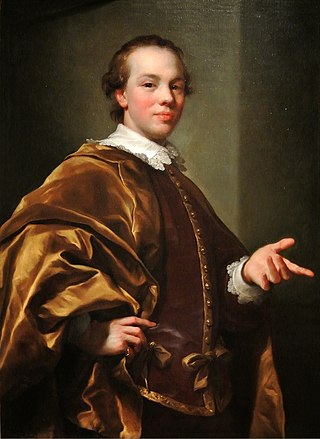| Earldom of Galloway | |
|---|---|
  Or, a fesse chequy azure and argent, surmounted of a bend engrailed gules, within a double tressure flory counterflory gules | |
| Creation date | 19 September 1623 [1] |
| Created by | James VI and I |
| Peerage | Peerage of Scotland |
| First holder | Alexander Stewart, 1st Earl of Galloway |
| Present holder | Andrew Clyde Stewart, 14th Earl of Galloway |
| Heir apparent | Alexander Stewart, Lord Garlies |
| Remainder to | First earl's heirs male of the body |
| Subsidiary titles | Lord Garlies Baron Stewart |
| Seat(s) | Cumloden House |
| Former seat(s) | Galloway House |
| Motto | Virescit vulnere virtus ("Courage grows strong at a wound") |

Earl of Galloway is a title in the Peerage of Scotland. It was created in 1623 for Alexander Stewart, 1st Lord Garlies, with remainder to his heirs male bearing the name and arms of Stewart. He had already been created Lord Garlies in the Peerage of Scotland in 1607, with remainder to the heirs male of his body succeeding to the estates of Garlies. This branch of the Stewart family were distant relatives of the Stewart Kings of Scotland. [1]
Contents
- Earls of Galloway (1623)
- Present peer
- Stewart baronets, of Burray (1687)
- See also
- Notes
- References
- External links
Lord Galloway was succeeded by his second but eldest surviving son, the second Earl. He had already been created a Baronet, of Corsewell in the county of Wigtown, in 1627. This title is in the Baronetage of Nova Scotia. His grandson, the fifth Earl (who had succeeded his elder brother, who in his turn had succeeded his father), was a politician. He was succeeded by his son, the sixth Earl. He was a Lord of Police. In 1704 Lord Galloway succeeded his kinsman Sir Archibald Stewart, 2nd Baronet, of Burray, as third Baronet of Burray (see below). On his death, the titles passed to his eldest son, the seventh Earl. He was a Member of Parliament and served as Lord-Lieutenant of Wigtownshire. From 1774 to 1796 he sat in the House of Lords as a Scottish representative peer. In 1796 Lord Galloway was created Baron Stewart of Garlies in the Peerage of Great Britain, which gave him an automatic seat in the House of Lords until the Peerage Act 1963 extended that right to all holders of Scottish peerages. He was succeeded by his son, the eighth Earl. He was an admiral in the Royal Navy, a Member of Parliament and Lord-Lieutenant of Kirkcudbrightshire and Wigtownshire. When he died the titles passed to his eldest son, the ninth Earl. He represented Cockermouth in the House of Commons and was Lord-Lieutenant of Kirkcudbrightshire and Wigtownshire. He was succeeded by his eldest son, the tenth Earl. He sat as Member of Parliament for Wigtownshire. On his death, the titles passed to his younger brother, the eleventh Earl. He was a soldier and fought in the Crimean War and in the Indian Rebellion of 1857. He was succeeded by his only son, the twelfth Earl. He served as Lord-Lieutenant of Kirkcudbrightshire. His only son, the thirteenth Earl, succeeded in 1978. The thirteenth Earl, who suffered from mental illness after being lobotomised at the age of 23, married, but died childless in 2020, upon which the line of descent from the eleventh earl failed. As of 2020 [update] the present holder of the titles is the thirteenth earl's second cousin once removed. He is the great-grandson of Major-General Hon. Alexander Stewart (1838–1896), the third son of the ninth Earl.
Several other members of the family have also gained distinction. The Hon. John Stewart, third son of the third Earl, was a brigadier-general in the army and also sat as Member of Parliament for Wigtownshire. The Hon. Keith Stewart, third son of the sixth Earl, was an Admiral and Member of Parliament. His son James Alexander Stewart-Mackenzie was Governor of Ceylon. His grandson was James Stewart-Mackenzie, 1st Baron Seaforth. The Hon. Montgomery Granville John Stewart, sixth son of the seventh Earl, represented Kirkcudbrightshire in the House of Commons. The Hon. James Henry Keith Stewart, eighth son of the seventh Earl, was Member of Parliament for Wigtown Burghs. The Hon. Keith Stewart (1814–1859), younger son of the eighth Earl, was an admiral in the Royal Navy.
The Stewart Baronetcy, of Burray in the County of Orkney, was created in the Baronetage of Nova Scotia on 4 November 1687 for Archibald Stewart. In 1704 the title was inherited by the aforementioned sixth Earl.
The Earls of Galloway are now considered to be the senior branch of Clan Stewart, [2] although their exact descent is debated. [3]
The family seat is Cumloden House, near Newton Stewart, Dumfries and Galloway. The former family seat was Galloway House, near Garlieston, Wigtownshire.











